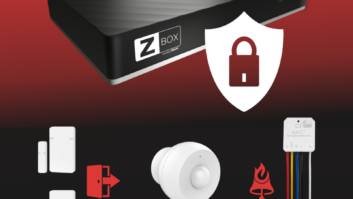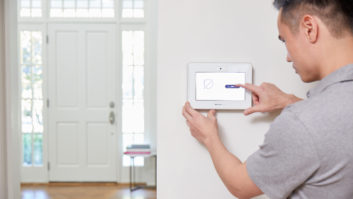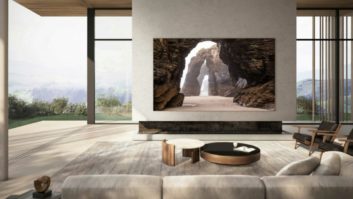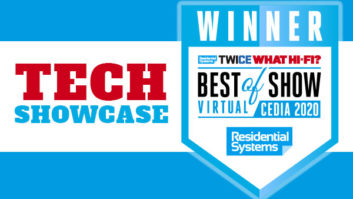Its a logical consideration for many custom installation companies: if you are already offering audiovisual, communications, and control, why not add security and life safety to your products and service roster in an effort to be a one-stop shop for busy owners of high-end homes?
As security and life safety shifts to the home network, this presents itself as a natural progression. The most significant trend is the convergence of all command and control in general, with security in the upper-end homes being incorporated into a single graphical user interface (GUI) that installers are incorporating into high-end systems, said Jim Paulson, general manager of commercial and residential solutions at GE Security (www.gesecurity.com). There is a heavy emphasis, particularly in the new construction marketplace, to have security integrate with other home automation, but also act as the hub for being able to control HVAC and lighting, while providing information in the homenot just security.
However, as with everything else involving the integration of residential technology, it is important to have an understanding of this specific facet of the industry, and all of the good and bad that comes with it.
There has been an explosion of false alarm problems, observed Chris Kangis, director of project design at Electronic Interiors Inc., in Hopedale, Massachusetts. There are many towns around the country that are going to a no-response scenario. If a monitoring company calls the police, they are not going to respond. That forces people to deal with no response, or hire a guard system to deal with it.
Kangis attributes this to the abundance of free or low-cost systems that have flooded the marketplace, delivered by organizations that base their business models on recurring revenue derived from monitoring services. Homeowners think they are buying security, but what they are really buying are recurring revenue systems, he said. If your goal is to sell a free system, you are not going to talk to people about doing things the right way, or what their specific needs are.
In lieu of offering security in-house, Kangis prefers to form alliances with reputable companies that specialize in the integration of high-end residential security systems. At the end of the day, security is as much or more service oriented than what we do, he declared. In the scheme of things, even if you do a high-end, custom security system, it is not going to be nearly as profitable as all of the other things that we integrators do now.
The volume of systems that a high-end residential custom installation firm would install each year doesnt necessarily make the endeavor worth it. Even if they are $25,000 security systems, which is way out of the standard, the amount of effort required for a $25,000 security system is much more than it is profitable, he said. Plus, if you are only doing that kind of volume, the recurring revenue side doesnt add up to that much.
Technologically, the skills required to install security and life safety are quite attainable to those familiar with A/V and home automation. Physically, someone who installs A/V systems could easily install security systems. But, just like anything in residential electronics, you cant assume that its simple; there are subtleties and complexities in everything, Kangis said. Once you know how to deal with them, its no problem. Security, by nature of the fact that it doesnt change as rapidly, makes it a lot easier to move from integration into security, because when you learn something, its going to pretty much stay what it is for a pretty long time, versus the other way around.
Bill Schafer, director of product and channel development at Crestron Electronics Inc., noted that, in the last several years, technological advancements are having an impact on security systems for the home. What I have noticed is the influx of low-cost, high-quality camera systems and DVRs for residential applications, he said. As far as life safety goes, I have seen some interesting automation solutions, in terms of panic buttons and things like that. A lot of advancement has been made in monitoring homes via the Internet and via web browsers. If my security system goes off, I can receive a notification via email. I can view my house via a web page at my office or while Im on vacation.
This is thanks to IP-addressable technology, which Shafer believes is going to continue to allow these systems to progress. We are only scratching the surface with the Internet, and with what we can do as far as control and monitoring over the Internet, as well as wireless connectivity, he said. I think that we are going to see a lot more happening with cell phones and PDAs tying into the home automation systems to provide more constant access to those systems. The wireless technologies in the home are going to dramatically increase over the few years, providing systems that couldnt be installed before available.
If a custom installation house decides that it makes sense to include security and life safety on its roster, Kangis instructs to go big or stay home. They should decide to do the best design and build of security systems and set themselves apart. Be as detailed and concerned about the details as you are hopefully on all of the other integration that you do.
Additionally, its necessary for custom installers to do their homework; life safety and security is accompanied by its own set of government-issued rules and regulations. Every town and every state has different regulations and licensing requirements. The liability that is involved with security is much different than A/V integration, because you are dealing with life safety, Kangis noted. You must have a different set of insurance packages and contracts. Along with that, they should connect with the local burglar and fire association to determine what the standard of practice is for this is very important.
As advancements continue to be made, the integration of security and life safety technology will become easier. We have been very assertive in taking it upon ourselves to reach out to manufacturers of security systems, DVRs, and cameras to make sure that our control systems interface seamlessly and fully with their technology, noted Jeffrey Singer, public relations manager at Crestron. These are vital systems for the home. They want these systems to be integrated into one system. We have partnered with these manufacturers to ensure that the right modules and codes exist so that our systems can communicate with theirs easily.
What I see the next several years bringing is a more consumer-friendly way for people to combine media, entertainment, and security to automate their lives, Paulson said. We believe that in most cases, the new construction market has been able to benefit the most by the convergence of these because it is pretty labor-intensive and its a hard-wired solution today. In new construction, there are no walls up preventing one from laying all that cable. In existing construction, thats not the case, but if you can provide that by using the existing powerline infrastructure that already exists in the home, or if you can do it wirelessly, clearly you are going to have the opportunity to move this convergence of entertainment and security up into a much larger existing home segment.
Carolyn Heinze ([email protected]) is a freelance writer/editor.







